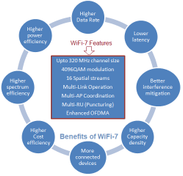Understanding 802.11ac Beamforming in WLAN
Advertisement
This page of the WLAN 802.11ac tutorial covers 802.11ac beamforming. Beamforming is the process in which transmission takes place by focusing energy towards a desired direction, targeted for a particular receiver. Hence, in addition to power, it helps increase the Signal-to-Noise Power Ratio (SNR) and, consequently, increases the data rate through the use of MIMO and complex modulation schemes like 256QAM. Beamforming is also referred to as beam steering.
Any device that shapes its transmitted frames is called a beamformer, and a receiver of these frames is called a beamformee. Prior to 802.11n, there were proprietary standards for beamforming; in IEEE 802.11n, beamforming is standardized.
There are two main types of beamforming: implicit and explicit. In 802.11ac, explicit channel measurements are performed by both the transmitter and receiver. Beamforming usually provides a gain of about 2 to 5 dB. The following figure depicts the beamforming process in 802.11ac.

In 802.11ac, the Null Data Packet (NDP) sounding method of beamforming is employed. Channel sounding in 802.11ac works as follows:
- The beamformer sends an NDP Announcement frame to the beamformee, which helps gain control of the channel. The beamformee responds to this frame.
- The beamformer sends a Null Data Packet (NDP), used by the beamformee to calculate the channel response and, hence, the steering matrix. For multiple users, multiple NDPs are sent to the receivers.
- The beamformee receives the NDP, calculates the feedback matrix, and sends it back to the beamformer.
- The beamformer calculates the steering matrix from the received feedback (FB) matrix and directs the transmission accordingly towards the beamformees.
There are other types of beamforming based on the number of users, namely single-user beamforming and multi-user beamforming.
Advertisement
 RF
RF

